Search Result
Results for "
targeted delivery
" in MedChemExpress (MCE) Product Catalog:
24
Biochemical Assay Reagents
| Cat. No. |
Product Name |
Target |
Research Areas |
Chemical Structure |
-
- HY-139819
-
|
|
Biochemical Assay Reagents
|
Others
|
|
MPEG-PLA (PEG MW 3000 & PLA MW 50,000) is a block copolymer, which can be used to preparenanoparticles for targeted drug delivery .
|
-
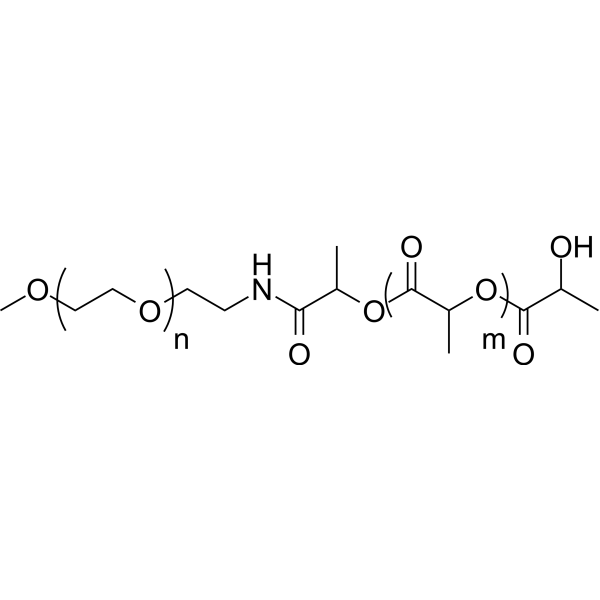
-
- HY-147354
-
|
|
LYTACs
|
Cardiovascular Disease
|
TriGalNAc CBz is a GalNAc derivative and tri-GalNAc is an asialoglycoprotein receptor (ASGPR) ligand. TriGalNAc CBz can be used for mRNA drug delivery as well as lysosomal targeted chimerism (LYTAC) studies .
|
-
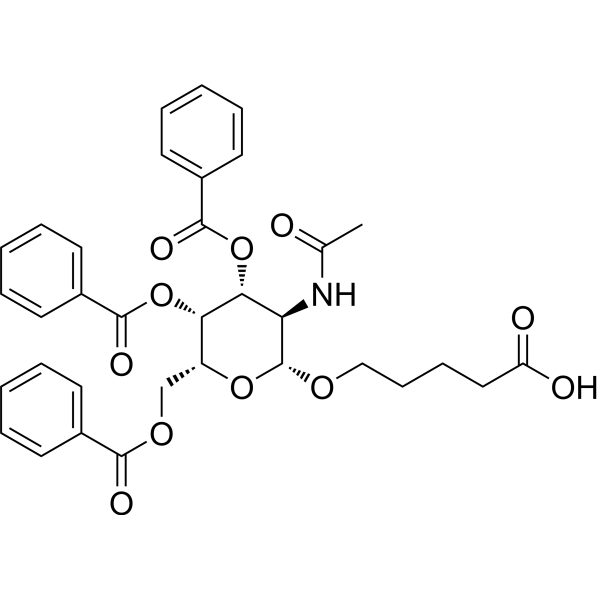
-
- HY-139818
-
|
|
Biochemical Assay Reagents
|
Others
|
|
Mal-PEG-PLA (PEG MW 3000 & PLA MW 70,000) is a block copolymer, which can be used to preparenanoparticles and micelles for targeted drug delivery .
|
-
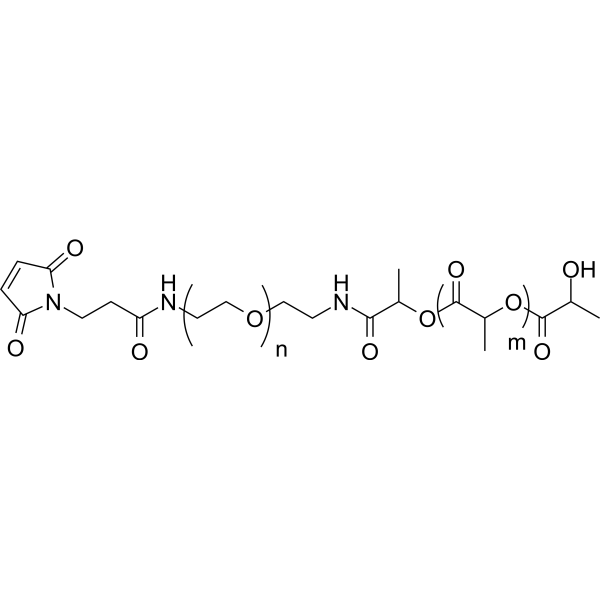
-
- HY-162472
-
|
|
ATM/ATR
DNA-PK
|
Cancer
|
|
XRD-0394 is a potent and specific dual inhibitor of ATM and DNA-PKcs with oral activity. XRD-0394 significantly enhances tumor cell killing in vitro and in vivo under therapeutic ionizing radiation conditions. In addition, XRD-0394 can potentiate the effects of PARP and topoisomerase I inhibitors in vitro .
|
-
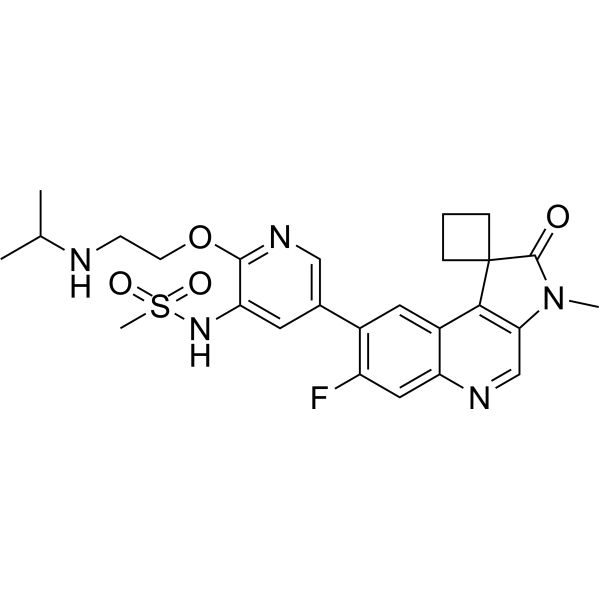
-
- HY-155321
-
-

-
- HY-P10055A
-
|
PSMA-1 TFA
|
PSMA
|
Cancer
|
|
PSMA targeting peptide TFA (PSMA-1 TFA) is a PSMA targeting peptide (GRFLTGGTGRLLRIS) and can be used for targeted delivery of glucose-regulated protein (GRP)-silencing siRNAs in PCa cells .
|
-
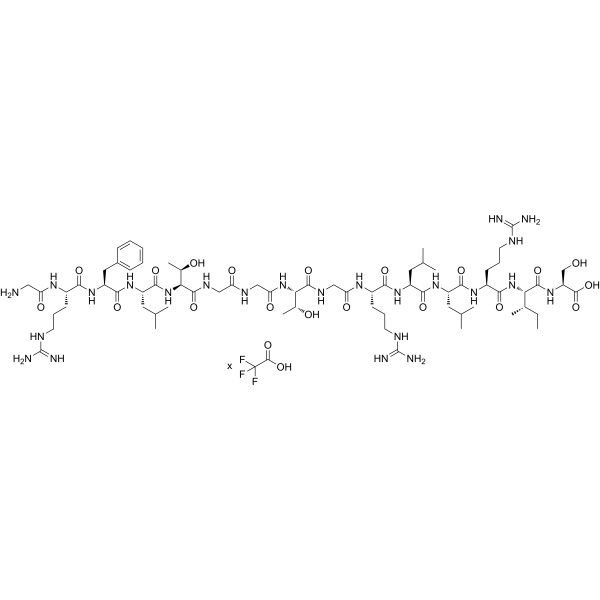
-
- HY-132994
-
|
|
Others
|
Others
|
|
TVD-0003510 is a carboxamide derivative, and involves in synthesis of (2-((6-(2-aminopyrimidine-5-carboxamido)-8-methoxy-3,4-dihydro-2H-pyrimido[1,2-c]quinazolin-9-yl)oxy)ethyl)piperazine-l-carboxylate (C51), as a part of tert-butyl2-(4-hydroxyphenyl)acetate .
|
-
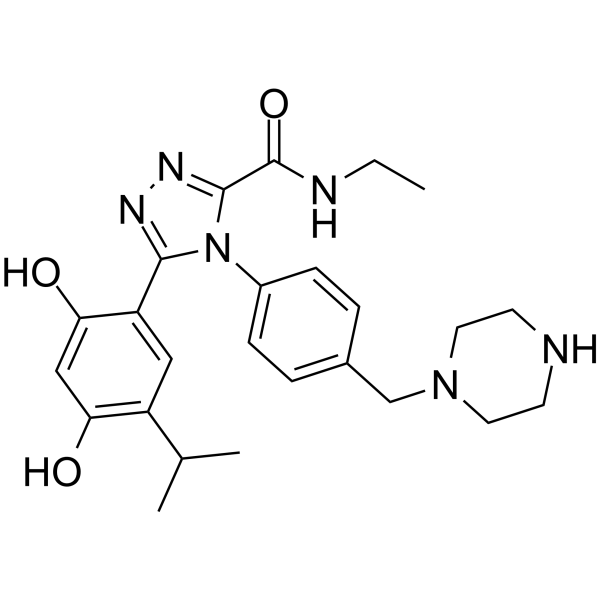
-
- HY-144001
-
|
|
Liposome
|
Others
|
|
DSPE-PEG-Carboxylic Acid is a phospholipid PEG conjugate. DSPE-PEG-Carboxylic Acid can be widely used in the delivery of targeted agents and genes .
|
-
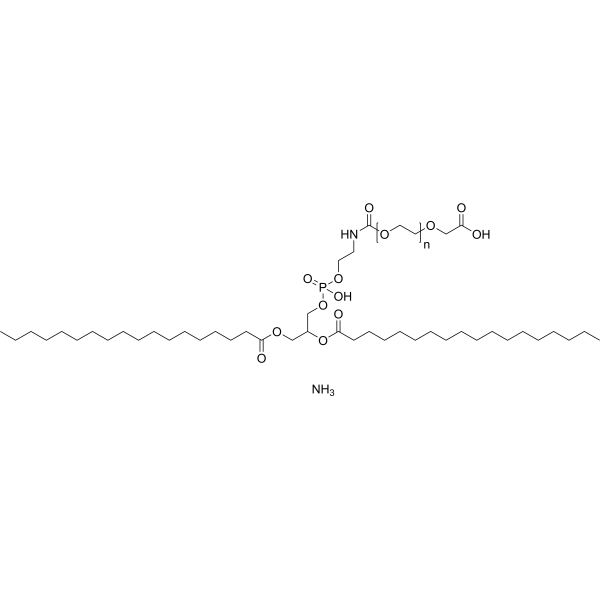
-
- HY-W011134
-
|
|
Others
|
Others
|
|
Palmitic acid N-hydroxysuccinimide is used to conjugate proteins to prepare targeted delivery vectors. Palmitic acid N-hydroxysuccinimide can be used as lipophilic electrophile .
|
-

-
- HY-W077028
-
|
|
Others
|
Others
|
|
N-(2-Hydroxypropyl)methacrylamide is used to synthesize copolymers for the targeted delivery of antileishmanial agents in Visceral leishmaniasis (VL) .
|
-

-
- HY-139413
-
|
|
Toll-like Receptor (TLR)
|
Cancer
|
|
β-D-glucan is a natural non-digestible polysaccharide and high biocompatibility that can be selectively recognized by recognition receptors such as Dectin-1 and Toll-like receptors as well as being easily internalized by murine or human macrophages, which is likely to attribute to a target delivery . β-d-glucan is an enteric delivery vehicle for probiotics .
|
-
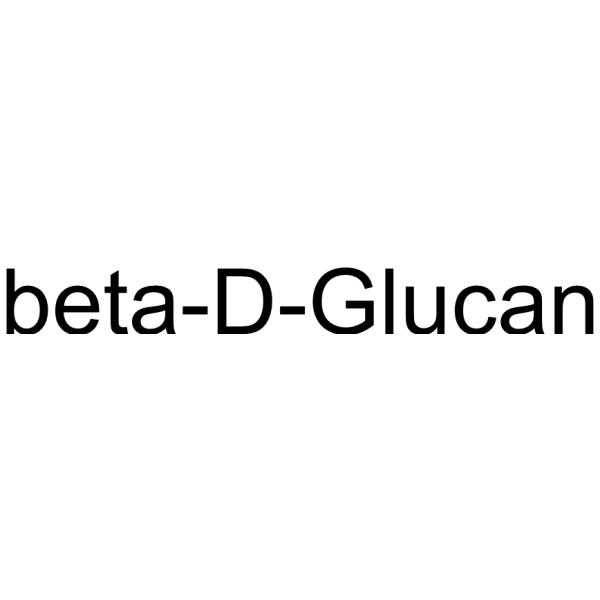
-
- HY-P99630
-
|
MM-302
|
EGFR
|
Cancer
|
|
Gancotamab (MM-302) is a HER2-targeted antibody-liposomal Doxorubicin conjugate with antitumor activity. Gancotamab encapsulates Doxorubicin to facilitate its delivery to HER2-overexpressing tumor cells .
|
-

-
- HY-W441014
-
|
|
Liposome
|
Others
|
|
DSPE-PEG-NHS, MW 2000 is a pegylated phospholipid derivatives which can be used to prepare liposome or lipid nanoparticles for targeted drug delivery system, such as DNA or mRNA vaccine.
|
-
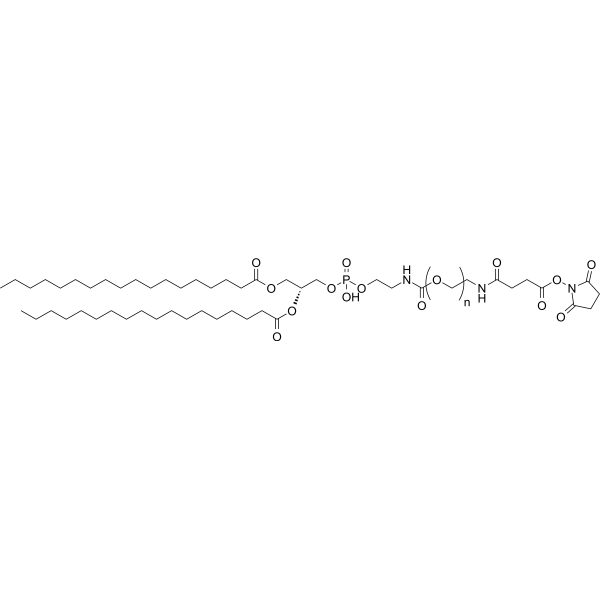
-
- HY-W441012
-
|
|
Liposome
|
Others
|
|
DSPE-PEG-NHS, MW 600 is a pegylated phospholipid derivatives which can be used to prepare liposome or lipid nanoparticles for targeted drug delivery system, such as DNA or mRNA vaccine.
|
-
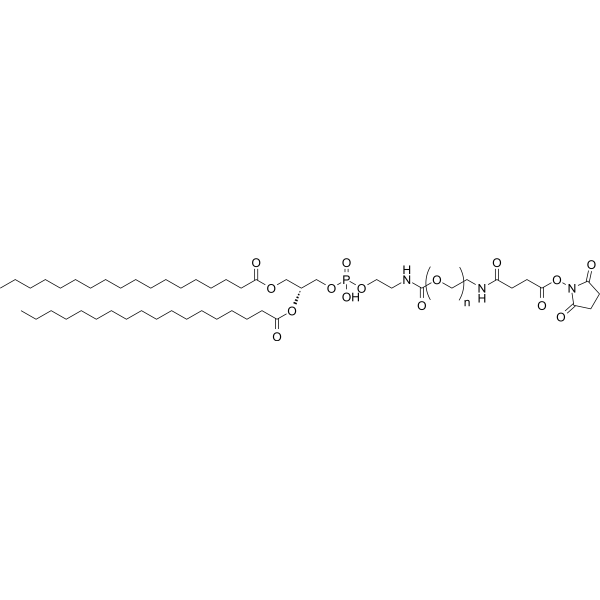
-
- HY-P4115
-
|
|
FABP
|
Cancer
|
|
CooP is a linear glioblastoma-targeting nonapeptide. CooP binds to the mammary-derived growth inhibitor/fatty acid binding protein 3 (FABP3) in the glioblastoma cells and its associated vasculature. CooP is used for the targeted delivery of chemotherapy and different nanoparticles .
|
-

-
- HY-132254
-
|
IMMU-132
|
Antibody-Drug Conjugates (ADCs)
|
Cancer
|
|
Sacituzumab govitecan (IMMU-132) is an antibody-drug conjugate (ADC) targeting Trop-2 for delivery of SN-38. Sacituzumab govitecan shows anticancer activity .
|
-

-
- HY-W441016
-
|
|
Liposome
|
Others
|
|
DSPE-PEG-NHS, MW 5000 is a pegylated phospholipid derivatives which can be used to prepare liposome or lipid nanoparticles for targeted drug delivery system, such as DNA or mRNA vaccine .
|
-
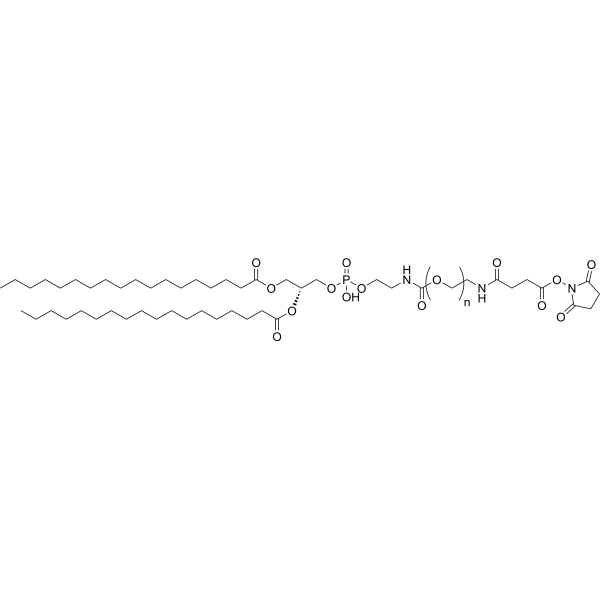
-
- HY-W441015A
-
|
|
Liposome
|
Others
|
|
DSPE-m-PEG-NHS (MW 3400) is a pegylated phospholipid derivatives which can be used to prepare liposome or lipid nanoparticles for targeted drug delivery system, such as DNA or mRNA vaccine.
|
-
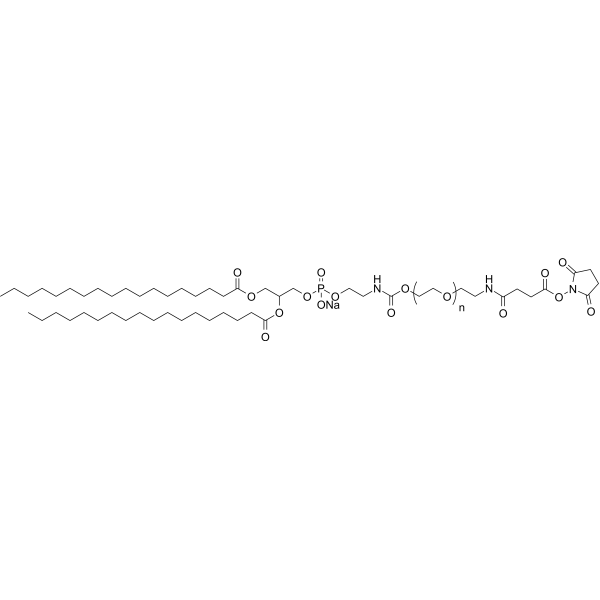
-
- HY-132254A
-
|
IMMU-132 (solution)
|
Antibody-Drug Conjugates (ADCs)
|
Cancer
|
|
Sacituzumab govitecan (IMMU-132) is an antibody-drug conjugate (ADC) targeting Trop-2 for delivery of SN-38. Sacituzumab govitecan shows anticancer activity .
|
-

-
- HY-145396
-
|
|
Others
|
Cancer
|
|
PLGA-PEG-NH2 is a material to synthesis nanomicelles. PLGA-PEG-NH2 nanomicelle is an efficient delivery system of Irinotecan for targeted colorectal cancer and hepatocellular carcinoma .
|
-
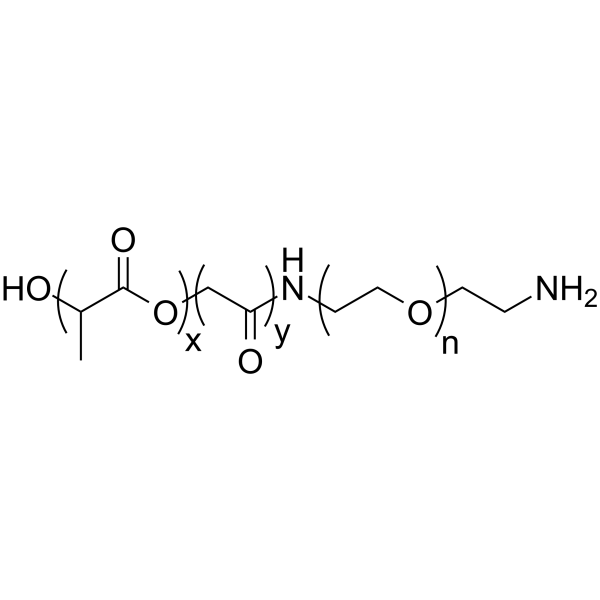
-
- HY-147077
-
|
|
Others
|
Inflammation/Immunology
|
|
Triantennary GalNAc-1 is a triantennary N-acetylgalactosamine (GalNAc) that can be conjugated to the 3' end of the sense strand of siRNA. GalNAc promotes targeted delivery of siRNA to liver cells both in vitro and in vivo [1].
|
-
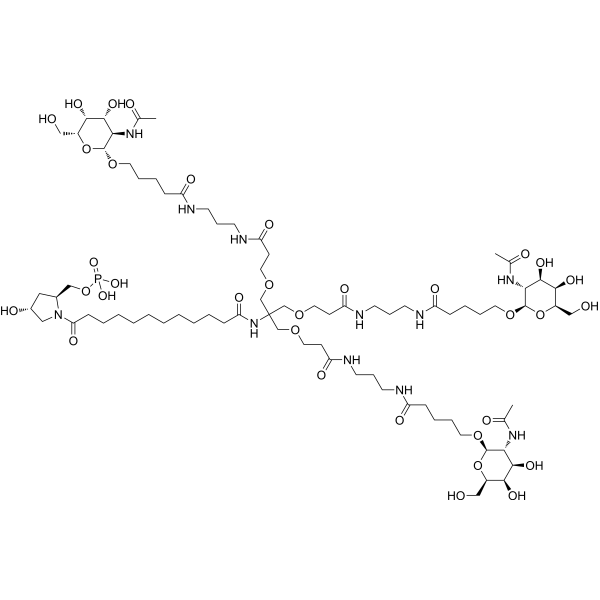
-
- HY-132828
-
-
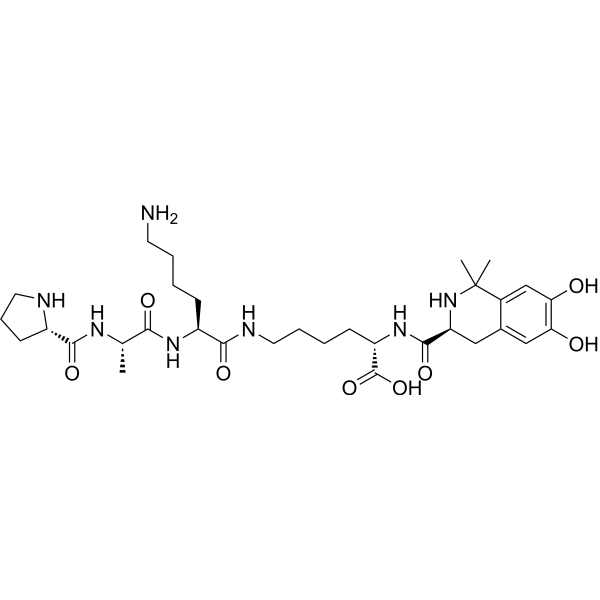
-
- HY-147119
-
-
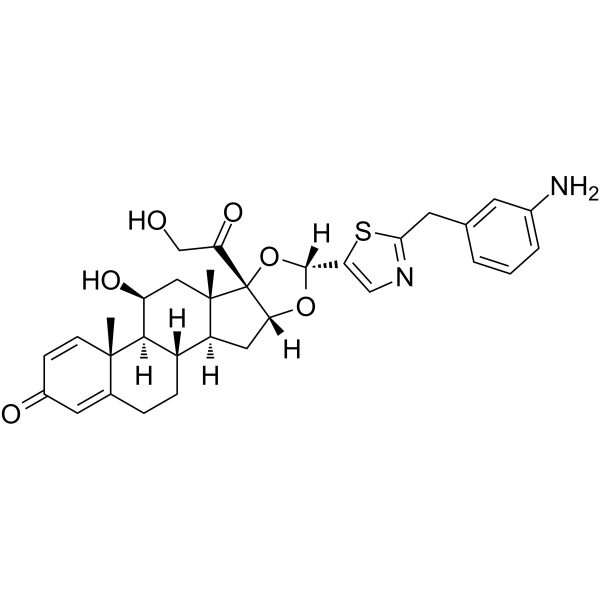
-
- HY-125619
-
|
|
Liposome
|
Others
|
|
1,2-dioctanoyl-sn-glycero-3-phosphocholine, is a phospholipid commonly used as a component of liposome formulations and drug delivery systems. 1,2-dioctanoyl-sn-glycero-3-phosphocholine has unique chemical properties that allow it to form stable bilayers and vesicles, allowing drug encapsulation and delivery to specific targets in the body. It acts as a stabilizer and emulsifier, which can improve the solubility and bioavailability of drugs.
|
-
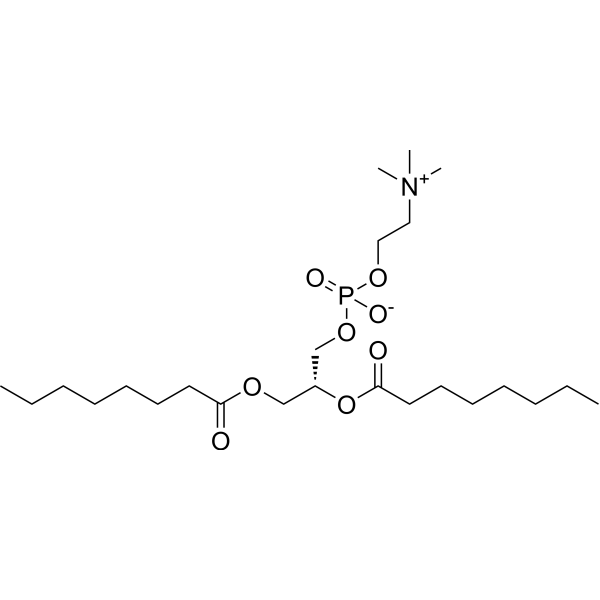
-
- HY-145323
-
|
|
Others
|
Cancer
|
|
Mitochondria-Targeted Photoactivatable Proagent accumulates in the mitochondria and shows light-triggered temporally controlled cell death. Mitochondria-Targeted Photoactivatable Proagent can be used in a novel drug delivery platform that provides on-demand, real-time, organelle-specific agent release and monitoring upon photoactivation .
|
-
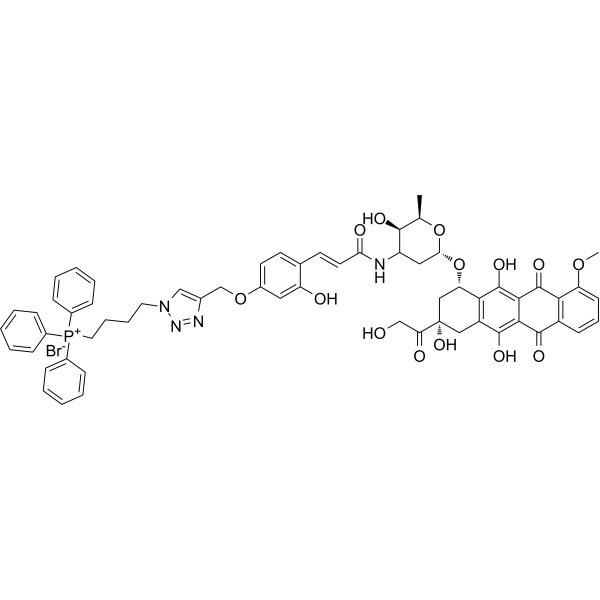
-
- HY-144009
-
|
|
Liposome
|
Cancer
|
|
DSPE-PEG-Folate, MW 3350 is a PEG derivative containing folic acid. DSPE-PEG-Folate has a targeting effect and bind to folate receptors in cancer cells. DSPE-PEG-Folate form micelles/lipid bilayer and can be used to targeted drug delivery system research .
|
-

-
- HY-163317
-
|
|
Somatostatin Receptor
|
Cancer
|
|
MMC(TMZ)-TOC has high binding affinity and selectivity for somatostatin receptor subtype-2 (SSTR2). MMC(TMZ)-TOC targets delivery of TMZ to SSTR2-positive tumor cells .
|
-

-
- HY-W440888
-
|
|
Liposome
|
Others
|
|
DSPE-PEG-Folate, MW 2000 is a PEG derivative containing folic acid. DSPE-PEG-Folate, MW 2000 has a targeting effect and bind to folate receptors in cancer cells. DSPE-PEG-Folate, MW 2000 form micelles/lipid bilayer and can be used to targeted drug delivery system research.
|
-
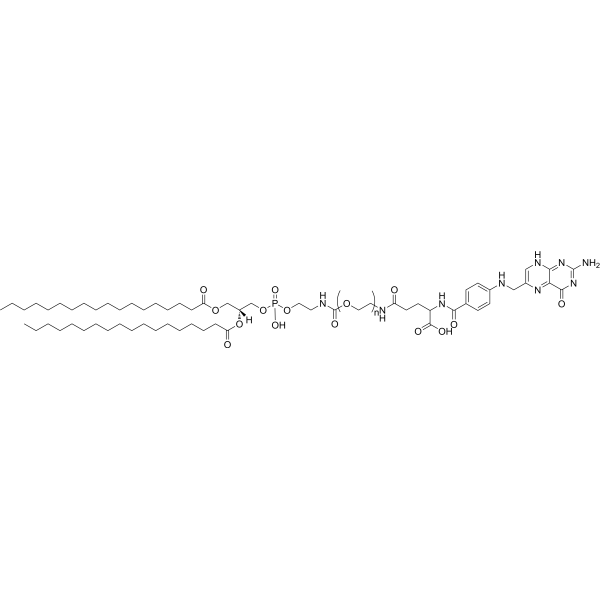
-
- HY-W440890
-
|
|
Liposome
|
Cancer
|
|
DSPE-PEG-Folate, MW 5000 is a PEG derivative containing folic acid. DSPE-PEG-Folate, MW 5000 has a targeting effect and bind to folate receptors in cancer cells. DSPE-PEG-Folate, MW 5000 form micelles/lipid bilayer and can be used to targeted drug delivery system research .
|
-
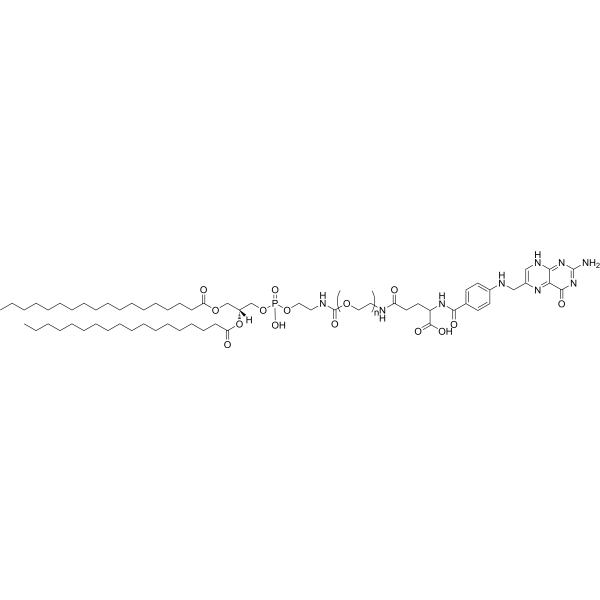
-
- HY-W440916
-
|
|
Liposome
|
|
|
DSPE-PEG-FITC, MW 3400 is a fluorescein attached PEG lipid. It can be used to prepare liposomes as drug carrier in targeted drug delivery. The polymer is modified with fluorescein (green) dye which can be used for staining cells, tissues, biomarkers, or nanoparticles.
|
-
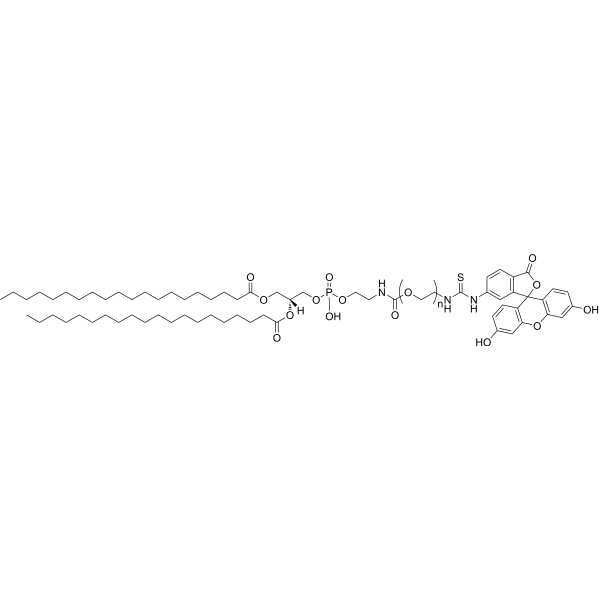
-
- HY-W440915
-
|
|
Liposome
|
|
|
DSPE-PEG-FITC, MW 2000 is a fluorescein attached PEG lipid. It can be used to prepare liposomes as drug carrier in targeted drug delivery. The polymer is modified with fluorescein (green) dye which can be used for staining cells, tissues, biomarkers, or nanoparticles.
|
-
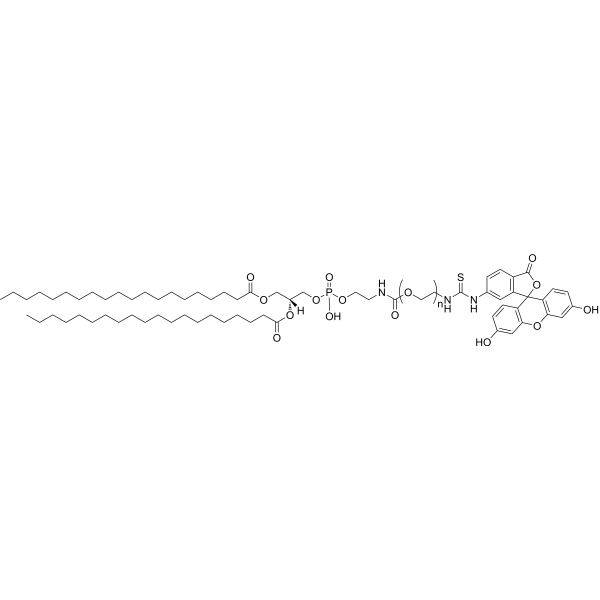
-
- HY-W440917
-
|
|
Liposome
|
|
|
DSPE-PEG-FITC, MW 5000 is a fluorescein attached PEG lipid. It can be used to prepare liposomes as drug carrier in targeted drug delivery. The polymer is modified with fluorescein (green) dye which can be used for staining cells, tissues, biomarkers, or nanoparticles.
|
-
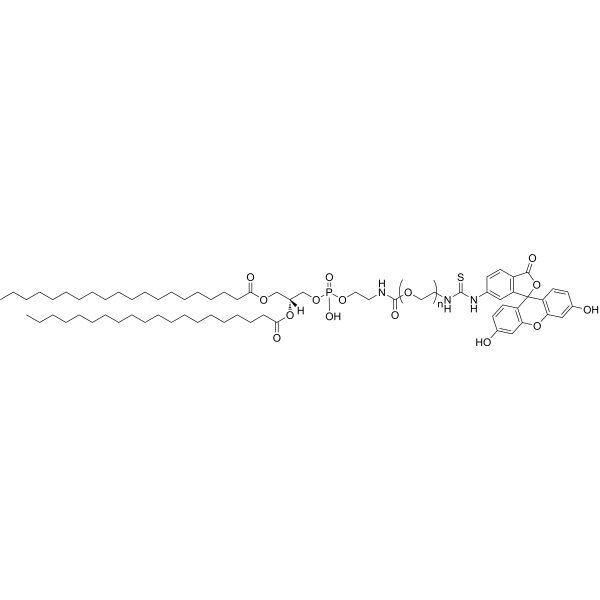
-
- HY-125036
-
|
|
PINK1/Parkin
|
Neurological Disease
|
|
MitoBloCK-11 is a new small molecule with a protein-binding target, Seo1. MitoBloCK-11 plays an important role in the delivery of PINK1 pathway. MitoBloCK-11 can be used in the study of autosomal recessive Parkinson's disease .
|
-
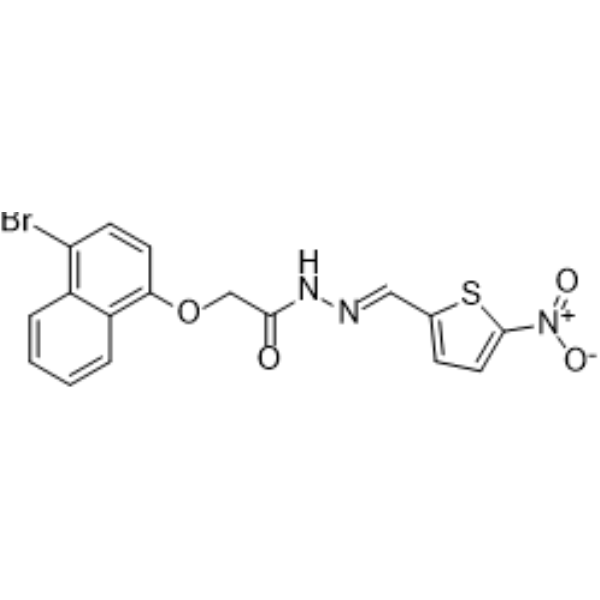
-
- HY-W440988
-
|
|
Liposome
|
Others
|
|
DOPE-mPEG, MW 2000 is a phospholipid polydisperse PEG (or DOPE liposome), can be used for preparation of targeted delivery of liposomal drug and giant unilamellar vesicles (GUVs). DOPE-mPEG, MW 2000 significantly reduces the pH-sensitivity of the liposome in a concentration dependent manner .
|
-
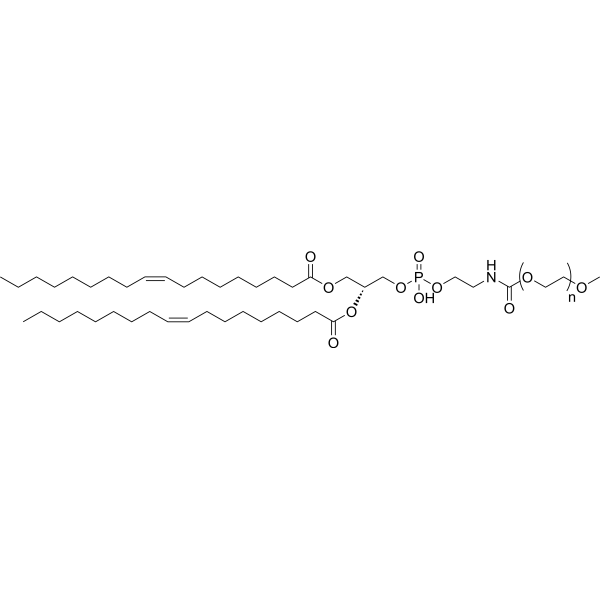
-
- HY-P5021
-
|
c(RGDfE)
|
Biochemical Assay Reagents
|
Cancer
|
|
Cyclo(Arg-Gly-Asp-(D-Phe)-Glu) (c(RGDfE)) is a cyclic RGD peptide that serves as a conjugated multifunctional nanodrug delivery system to target Gemcitabine to pancreatic cancer cells. Cyclo(Arg-Gly-Asp-(D-Phe)-Glu) can be used in cancer research .
|
-
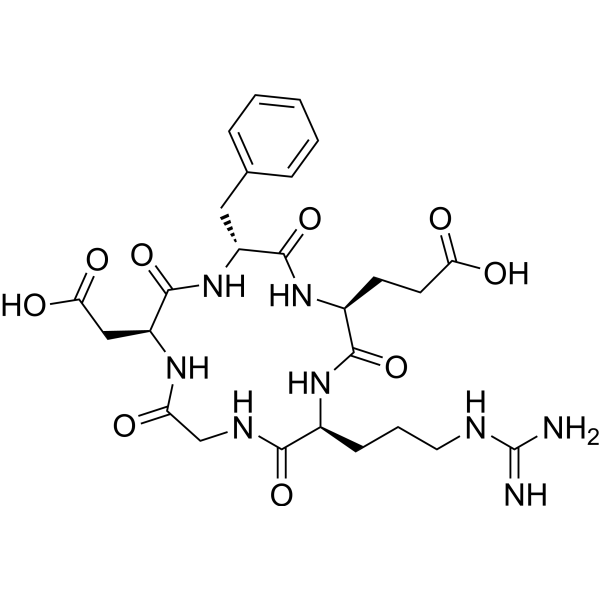
-
- HY-W440921
-
|
|
Liposome
|
|
|
DSPE-PEG-Rhodamine, MW 5000 is a phospholipid polyPEG with red fluorescent. The polymer can form lipid bilayer and be used to prepare nanoparticles or liposomes for targeted drug delivery. Rhodamine has maximum absorption at 570 nm and emission around 595 nm and can be easily traced using an imaging technique.
|
-
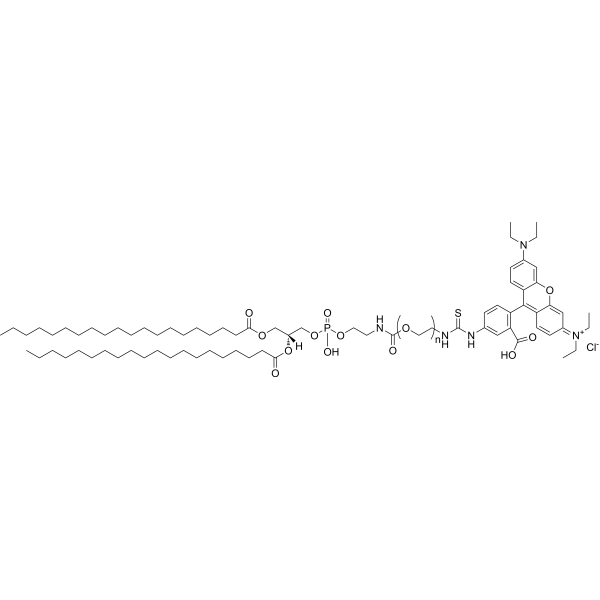
-
- HY-W440920
-
|
|
Liposome
|
|
|
DSPE-PEG-Rhodamine, MW 3400 is a phospholipid polyPEG with red fluorescent. The polymer can form lipid bilayer and be used to prepare nanoparticles or liposomes for targeted drug delivery. Rhodamine has maximum absorption at 570 nm and emission around 595 nm and can be easily traced using an imaging technique.
|
-

-
- HY-D0835
-
|
Hydroxyapatite
|
|
|
|
Hydroxylapatite (Hydroxyapatite) is a naturally occurring calcium phosphate which is a major mineral component of bone and teeth bones. Nano-scale Hydroxylapatite particles are increasingly being used as carriers for controlled and targeted delivery of bioactive agents like agents, proteins, and nucleic acids due to their high porosity, negative charge, and biodegradability .
|
-

-
- HY-152229
-
|
|
Liposome
|
Cancer
|
|
G0-C14 is a cationic lipid-like compound alkyl-modified polyamidoamine (PAMAM) dendrimer. G0-C14 involves in the preparation of a series of macrophage-targeted nanoparticles (NPs). NPs can be used for agent and vaccine delivery .
|
-
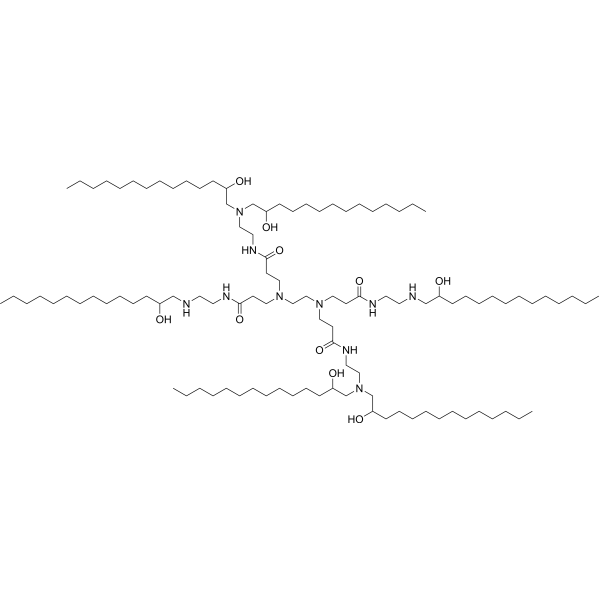
-
- HY-W074975
-
|
5-Amino-1,3,4-thiadiazole-2-sulfonamide
|
Carbonic Anhydrase
|
Cancer
|
|
CL 5343 (5-Amino-1,3,4-thiadiazole-2-sulfonamide) is an inhibitor of human carbonic anhydrase B (HCA-B). CL 5343 can serve as a CA9 ligand to achieve the targeted delivery of maytansinoid to the cell membrane of SKRC52 renal cancer cells .
|
-

-
- HY-D1719A
-
|
|
Fluorescent Dye
|
Cancer
|
|
Cypate is a near-infrared fluorescent dye that belongs to the family of photosensitizers. Cypate has high photostability and optical properties, and is often used in near-infrared optical imaging, as well as optical imaging, tumor marking, and drug delivery. In addition, Cypate is also used as a molecular probe and combined with targeting molecules (such as CBT or small interfering RNA) to achieve efficient detection and imaging of specific cells or tissues .
|
-
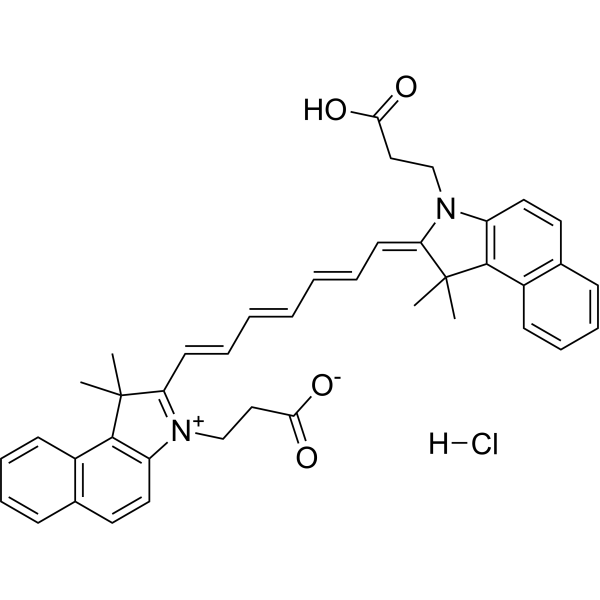
-
- HY-115415
-
|
|
Liposome
|
Others
|
|
1,2-Distearoyl-sn-glycero-3-phosphate, sodium salt is a phospholipid commonly used as a component of liposome formulations and drug delivery systems. 1,2-Distearoyl-sn-glycero-3-phosphate, sodium salt has unique chemical properties that make it an effective tool for encapsulating drugs and delivering them to specific targets in the body. It acts as a stabilizer and emulsifier, which can improve the solubility and bioavailability of drugs.
|
-
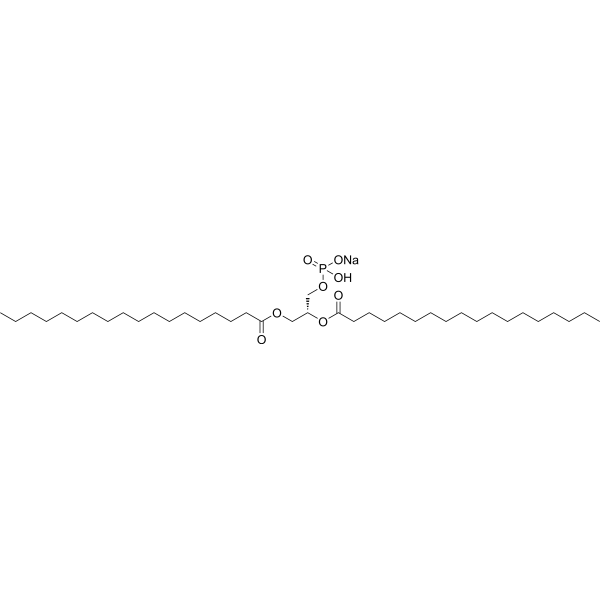
-
- HY-155887
-
|
DSPE-PEG-NH2, MW 3400 ammonium
|
Liposome
|
Others
|
|
DSPE-PEG-Amine, MW 3400 (ammonium) is a phosphoethanolamine involved in the synthesis of liposomes for delivery systems. The amino group of DSPE-PEG-Amine, MW 3400 (ammonium) can be converted to aromatic aldehydes by reacting with acetone-protected aromatic hydrazines on the surface of bovine carbonic anhydrase (BCA) molecules. Liposomes form a liposome-BAH-BCA conjugate by forming a bisarylhydrazone (BAH) with the target enzyme molecule. The conjugate catalyzes the hydration of carbon dioxide to bicarbonate.
|
-

-
- HY-155908
-
|
DSPE-PEG-NH2, MW 10000 ammonium
|
Liposome
|
Others
|
|
DSPE-PEG-Amine, MW 10000 (ammonium) is a phosphoethanolamine involved in the synthesis of liposomes for delivery systems. The amino group of DSPE-PEG-Amine, MW 10000 (ammonium) can be converted into aromatic aldehydes by reacting with acetone-protected aromatic hydrazines on the surface of bovine carbonic anhydrase (BCA) molecules. Liposomes form a liposome-BAH-BCA conjugate by forming a bisarylhydrazone (BAH) with the target enzyme molecule. The conjugate catalyzes the hydration of carbon dioxide to bicarbonate.
|
-
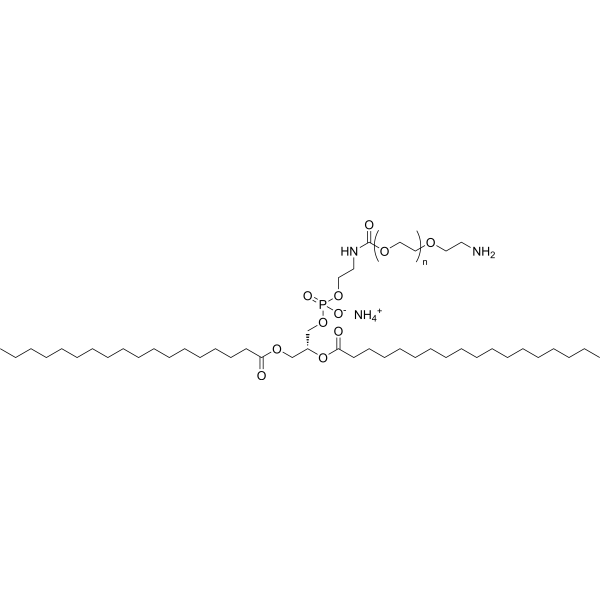
-
- HY-112624B
-
|
Dextran 70; Dextran D70; Dextran T70(MW 64000-76000)
|
Biochemical Assay Reagents
|
Others
|
|
Dextran T70 (MW 70,000) is a complex carbohydrate polymer consisting of glucose molecules linked by glycosidic bonds. Dextran has excellent solubility in water, making it useful as a viscosity modifier or stabilizer in foods, paints and adhesives. In the biomedical field, dextran is often used as a plasma expander because of its ability to increase blood volume when administered intravenously. It can also be modified to create dextran-based drug delivery systems, such as targeted nanoparticles.
|
-

-
- HY-155907
-
|
DSPE-PEG-NH2, MW 5000 ammonium
|
Liposome
|
Others
|
|
DSPE-PEG-Amine, MW 5000 (ammonium) is a phosphoethanolamine involved in the synthesis of liposomes for delivery systems. DSPE-PEG-Amine, MW 5000 (ammonium) amino group can be converted to aromatic aldehydes that react with acetone-protected aromatic hydrazides on the surface of the bovine carbonic anhydrase (BCA) molecule. Liposomes produce liposome-Bah-BCA conjugates by forming diaryl hydrazone (BAH) with target enzyme molecules. The conjugate catalyzes the hydration of carbon dioxide to bicarbonate.
|
-
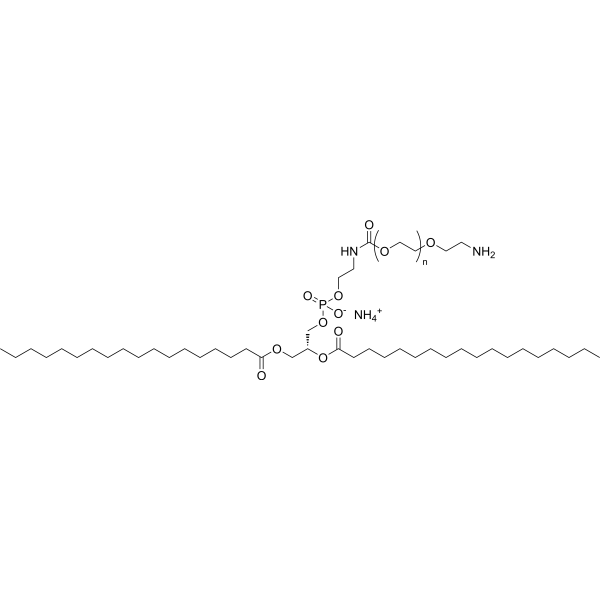
-
- HY-W440823A
-
|
DSPE-PEG-NH2, MW 1000 ammonium
|
Liposome
|
Others
|
|
DSPE-PEG-Amine, MW 1000 (ammonium) is a phosphoethanolamine involved in the synthesis of liposomes for delivery systems. The amino group of DSPE-PEG-Amine, MW 1000 (ammonium) can be converted to an aromatic aldehyde, which reacts with an acetone-protected aromatic hydrazine on the surface of the bovine carbonic anhydrase (BCA) molecule. Liposomes form a liposome-BAH-BCA conjugate by forming a bisarylhydrazone (BAH) with the target enzyme molecule. The conjugate catalyzes the hydration of carbon dioxide to bicarbonate.
|
-

-
- HY-W250308
-
|
Epsilon-polylysine; ε-Polylysine; ε-PL
|
Bacterial
|
Others
|
|
Epsilon-polylysine is an antimicrobial peptide that can be produced by bacteria such as Streptomyces. Epsilon-polylysine inhibits the growth of microorganisms such as bacteria, yeasts and molds and is therefore often used as a green food additive and preservative in various food and beverage products. Epsilon-polylysine has a variety of properties, including thermal stability, resistance to acidic conditions, and broad-spectrum antimicrobial activity. Epsilon-polylysine can be loaded on other materials to form nanoparticles or form nanofiber membranes for targeted delivery to exert sustained antibacterial efficacy. Epsilon-polylysine is also used as a liposome stabilizer .
|
-
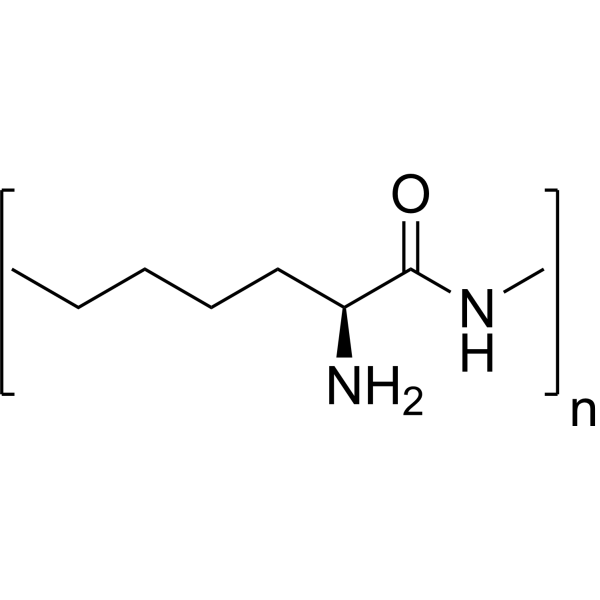
-
- HY-153083
-
|
|
SARS-CoV
|
Infection
|
|
COVID-19 Spike Protein mRNA will express COVID-19 spike protein, and suitable for detection of RNA delivery, translation efficiency, cell viability, etc. COVID-19 spike protein is the novel coronavirus pneumonia spike protein located on the membrane surface. COVID-19 spike protein undertakes the functions of virus binding to host cell membrane receptors and membrane fusion, thereby mediating the entry of COVID-19 virus into cells. COVID-19 spike protein is an important site of action for host neutralizing antibodies and a key target for vaccine design .
|
-
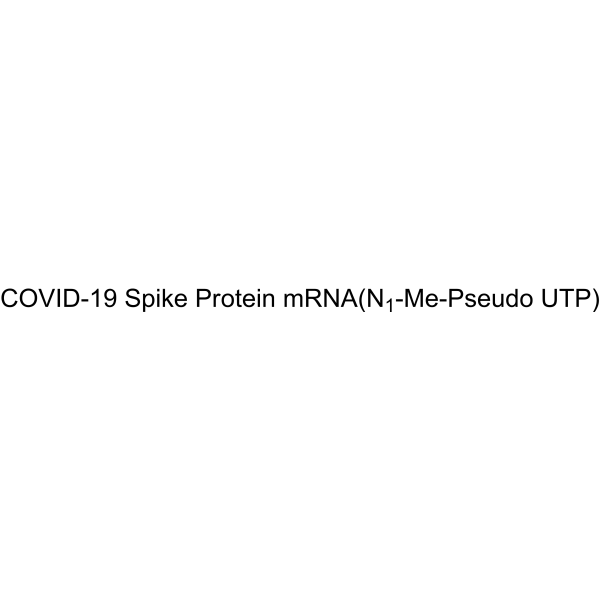
-
- HY-153235
-
|
|
SARS-CoV
Liposome
|
Infection
|
|
COVID-19 Spike Protein mRNA-LNP is a lipid nanoparticle (LNP) containing COVID-19 Spike Protein, suitable for detection of RNA delivery, translation efficiency, cell viability, etc. COVID-19 Spike Protein is the novel coronavirus pneumonia spike protein located on the membrane surface. COVID-19 Spike Protein undertakes the functions of virus binding to host cell membrane receptors and membrane fusion, thereby mediating the entry of COVID-19 virus into cells. COVID-19 Spike Protein is an important site of action for host neutralizing antibodies and a key target for vaccine design .
|
-

| Cat. No. |
Product Name |
Type |
-
- HY-139413
-
|
|
Biochemical Assay Reagents
|
|
β-D-glucan is a natural non-digestible polysaccharide and high biocompatibility that can be selectively recognized by recognition receptors such as Dectin-1 and Toll-like receptors as well as being easily internalized by murine or human macrophages, which is likely to attribute to a target delivery . β-d-glucan is an enteric delivery vehicle for probiotics .
|
-
- HY-W441014
-
|
|
Drug Delivery
|
|
DSPE-PEG-NHS, MW 2000 is a pegylated phospholipid derivatives which can be used to prepare liposome or lipid nanoparticles for targeted drug delivery system, such as DNA or mRNA vaccine.
|
-
- HY-144001
-
|
|
Drug Delivery
|
|
DSPE-PEG-Carboxylic Acid is a phospholipid PEG conjugate. DSPE-PEG-Carboxylic Acid can be widely used in the delivery of targeted agents and genes .
|
-
- HY-W441012
-
|
|
Drug Delivery
|
|
DSPE-PEG-NHS, MW 600 is a pegylated phospholipid derivatives which can be used to prepare liposome or lipid nanoparticles for targeted drug delivery system, such as DNA or mRNA vaccine.
|
-
- HY-W441015A
-
|
|
Drug Delivery
|
|
DSPE-m-PEG-NHS (MW 3400) is a pegylated phospholipid derivatives which can be used to prepare liposome or lipid nanoparticles for targeted drug delivery system, such as DNA or mRNA vaccine.
|
-
- HY-125619
-
|
|
Drug Delivery
|
|
1,2-dioctanoyl-sn-glycero-3-phosphocholine, is a phospholipid commonly used as a component of liposome formulations and drug delivery systems. 1,2-dioctanoyl-sn-glycero-3-phosphocholine has unique chemical properties that allow it to form stable bilayers and vesicles, allowing drug encapsulation and delivery to specific targets in the body. It acts as a stabilizer and emulsifier, which can improve the solubility and bioavailability of drugs.
|
-
- HY-144009
-
|
|
Drug Delivery
|
|
DSPE-PEG-Folate, MW 3350 is a PEG derivative containing folic acid. DSPE-PEG-Folate has a targeting effect and bind to folate receptors in cancer cells. DSPE-PEG-Folate form micelles/lipid bilayer and can be used to targeted drug delivery system research .
|
-
- HY-W440888
-
|
|
Drug Delivery
|
|
DSPE-PEG-Folate, MW 2000 is a PEG derivative containing folic acid. DSPE-PEG-Folate, MW 2000 has a targeting effect and bind to folate receptors in cancer cells. DSPE-PEG-Folate, MW 2000 form micelles/lipid bilayer and can be used to targeted drug delivery system research.
|
-
- HY-W440890
-
|
|
Drug Delivery
|
|
DSPE-PEG-Folate, MW 5000 is a PEG derivative containing folic acid. DSPE-PEG-Folate, MW 5000 has a targeting effect and bind to folate receptors in cancer cells. DSPE-PEG-Folate, MW 5000 form micelles/lipid bilayer and can be used to targeted drug delivery system research .
|
-
- HY-W440916
-
|
|
Drug Delivery
|
|
DSPE-PEG-FITC, MW 3400 is a fluorescein attached PEG lipid. It can be used to prepare liposomes as drug carrier in targeted drug delivery. The polymer is modified with fluorescein (green) dye which can be used for staining cells, tissues, biomarkers, or nanoparticles.
|
-
- HY-W440915
-
|
|
Drug Delivery
|
|
DSPE-PEG-FITC, MW 2000 is a fluorescein attached PEG lipid. It can be used to prepare liposomes as drug carrier in targeted drug delivery. The polymer is modified with fluorescein (green) dye which can be used for staining cells, tissues, biomarkers, or nanoparticles.
|
-
- HY-W440917
-
|
|
Drug Delivery
|
|
DSPE-PEG-FITC, MW 5000 is a fluorescein attached PEG lipid. It can be used to prepare liposomes as drug carrier in targeted drug delivery. The polymer is modified with fluorescein (green) dye which can be used for staining cells, tissues, biomarkers, or nanoparticles.
|
-
- HY-W440988
-
|
|
Drug Delivery
|
|
DOPE-mPEG, MW 2000 is a phospholipid polydisperse PEG (or DOPE liposome), can be used for preparation of targeted delivery of liposomal drug and giant unilamellar vesicles (GUVs). DOPE-mPEG, MW 2000 significantly reduces the pH-sensitivity of the liposome in a concentration dependent manner .
|
-
- HY-W440921
-
|
|
Drug Delivery
|
|
DSPE-PEG-Rhodamine, MW 5000 is a phospholipid polyPEG with red fluorescent. The polymer can form lipid bilayer and be used to prepare nanoparticles or liposomes for targeted drug delivery. Rhodamine has maximum absorption at 570 nm and emission around 595 nm and can be easily traced using an imaging technique.
|
-
- HY-W440920
-
|
|
Drug Delivery
|
|
DSPE-PEG-Rhodamine, MW 3400 is a phospholipid polyPEG with red fluorescent. The polymer can form lipid bilayer and be used to prepare nanoparticles or liposomes for targeted drug delivery. Rhodamine has maximum absorption at 570 nm and emission around 595 nm and can be easily traced using an imaging technique.
|
-
- HY-152229
-
|
|
Drug Delivery
|
|
G0-C14 is a cationic lipid-like compound alkyl-modified polyamidoamine (PAMAM) dendrimer. G0-C14 involves in the preparation of a series of macrophage-targeted nanoparticles (NPs). NPs can be used for agent and vaccine delivery .
|
-
- HY-115415
-
|
|
Drug Delivery
|
|
1,2-Distearoyl-sn-glycero-3-phosphate, sodium salt is a phospholipid commonly used as a component of liposome formulations and drug delivery systems. 1,2-Distearoyl-sn-glycero-3-phosphate, sodium salt has unique chemical properties that make it an effective tool for encapsulating drugs and delivering them to specific targets in the body. It acts as a stabilizer and emulsifier, which can improve the solubility and bioavailability of drugs.
|
-
- HY-155887
-
|
DSPE-PEG-NH2, MW 3400 ammonium
|
Drug Delivery
|
|
DSPE-PEG-Amine, MW 3400 (ammonium) is a phosphoethanolamine involved in the synthesis of liposomes for delivery systems. The amino group of DSPE-PEG-Amine, MW 3400 (ammonium) can be converted to aromatic aldehydes by reacting with acetone-protected aromatic hydrazines on the surface of bovine carbonic anhydrase (BCA) molecules. Liposomes form a liposome-BAH-BCA conjugate by forming a bisarylhydrazone (BAH) with the target enzyme molecule. The conjugate catalyzes the hydration of carbon dioxide to bicarbonate.
|
-
- HY-155908
-
|
DSPE-PEG-NH2, MW 10000 ammonium
|
Drug Delivery
|
|
DSPE-PEG-Amine, MW 10000 (ammonium) is a phosphoethanolamine involved in the synthesis of liposomes for delivery systems. The amino group of DSPE-PEG-Amine, MW 10000 (ammonium) can be converted into aromatic aldehydes by reacting with acetone-protected aromatic hydrazines on the surface of bovine carbonic anhydrase (BCA) molecules. Liposomes form a liposome-BAH-BCA conjugate by forming a bisarylhydrazone (BAH) with the target enzyme molecule. The conjugate catalyzes the hydration of carbon dioxide to bicarbonate.
|
-
- HY-112624B
-
|
Dextran 70; Dextran D70; Dextran T70(MW 64000-76000)
|
Drug Delivery
Thickeners
|
|
Dextran T70 (MW 70,000) is a complex carbohydrate polymer consisting of glucose molecules linked by glycosidic bonds. Dextran has excellent solubility in water, making it useful as a viscosity modifier or stabilizer in foods, paints and adhesives. In the biomedical field, dextran is often used as a plasma expander because of its ability to increase blood volume when administered intravenously. It can also be modified to create dextran-based drug delivery systems, such as targeted nanoparticles.
|
-
- HY-155907
-
|
DSPE-PEG-NH2, MW 5000 ammonium
|
Drug Delivery
|
|
DSPE-PEG-Amine, MW 5000 (ammonium) is a phosphoethanolamine involved in the synthesis of liposomes for delivery systems. DSPE-PEG-Amine, MW 5000 (ammonium) amino group can be converted to aromatic aldehydes that react with acetone-protected aromatic hydrazides on the surface of the bovine carbonic anhydrase (BCA) molecule. Liposomes produce liposome-Bah-BCA conjugates by forming diaryl hydrazone (BAH) with target enzyme molecules. The conjugate catalyzes the hydration of carbon dioxide to bicarbonate.
|
-
- HY-W440823A
-
|
DSPE-PEG-NH2, MW 1000 ammonium
|
Drug Delivery
|
|
DSPE-PEG-Amine, MW 1000 (ammonium) is a phosphoethanolamine involved in the synthesis of liposomes for delivery systems. The amino group of DSPE-PEG-Amine, MW 1000 (ammonium) can be converted to an aromatic aldehyde, which reacts with an acetone-protected aromatic hydrazine on the surface of the bovine carbonic anhydrase (BCA) molecule. Liposomes form a liposome-BAH-BCA conjugate by forming a bisarylhydrazone (BAH) with the target enzyme molecule. The conjugate catalyzes the hydration of carbon dioxide to bicarbonate.
|
-
- HY-W250308
-
|
Epsilon-polylysine; ε-Polylysine; ε-PL
|
Biochemical Assay Reagents
|
|
Epsilon-polylysine is an antimicrobial peptide that can be produced by bacteria such as Streptomyces. Epsilon-polylysine inhibits the growth of microorganisms such as bacteria, yeasts and molds and is therefore often used as a green food additive and preservative in various food and beverage products. Epsilon-polylysine has a variety of properties, including thermal stability, resistance to acidic conditions, and broad-spectrum antimicrobial activity. Epsilon-polylysine can be loaded on other materials to form nanoparticles or form nanofiber membranes for targeted delivery to exert sustained antibacterial efficacy. Epsilon-polylysine is also used as a liposome stabilizer .
|
-
- HY-153235
-
|
|
Drug Delivery
|
|
COVID-19 Spike Protein mRNA-LNP is a lipid nanoparticle (LNP) containing COVID-19 Spike Protein, suitable for detection of RNA delivery, translation efficiency, cell viability, etc. COVID-19 Spike Protein is the novel coronavirus pneumonia spike protein located on the membrane surface. COVID-19 Spike Protein undertakes the functions of virus binding to host cell membrane receptors and membrane fusion, thereby mediating the entry of COVID-19 virus into cells. COVID-19 Spike Protein is an important site of action for host neutralizing antibodies and a key target for vaccine design .
|
| Cat. No. |
Product Name |
Target |
Research Area |
-
- HY-P10055A
-
|
PSMA-1 TFA
|
PSMA
|
Cancer
|
|
PSMA targeting peptide TFA (PSMA-1 TFA) is a PSMA targeting peptide (GRFLTGGTGRLLRIS) and can be used for targeted delivery of glucose-regulated protein (GRP)-silencing siRNAs in PCa cells .
|
-
- HY-P4084A
-
|
|
Peptides
|
Others
|
|
KLA seq acetate is a cell membrane-penetrating α-helical amphipathic model peptide. KLA seq acetate conjugates peptide nucleic acids (PNAs) for delivery to mammalian cells. KLA seq acetate covalently links targeted mRNA and fluorescein to form a delivery system that has low re-export and is less resistant to serum effects .
|
-
- HY-P4102
-
|
|
Peptides
|
Cancer
|
|
Cyclic PSAP peptide is a cyclic pentapeptide (DWLPK). Cyclic PSAP peptide exhibits agent-like properties and could inhibit metastatic spread and restrain tumor development in general in vivo .
|
-
- HY-P4115
-
|
|
FABP
|
Cancer
|
|
CooP is a linear glioblastoma-targeting nonapeptide. CooP binds to the mammary-derived growth inhibitor/fatty acid binding protein 3 (FABP3) in the glioblastoma cells and its associated vasculature. CooP is used for the targeted delivery of chemotherapy and different nanoparticles .
|
-
- HY-P10216
-
|
|
Peptides
|
Others
|
|
CAQK peptide selectively binds to injured mouse brain. CAQK peptide selectively targets demyelinating areas and it is absent from healthy tissue. The CAQK peptide target is a proteoglycan complex upregulated in brain injuries and is used for drug delivery. CAQK peptide can penetrate the blood-brain barrier .
|
-
- HY-P10128
-
|
|
Peptides
|
Inflammation/Immunology
|
|
GE11 is a active peptide and combines with colloidal drug delivery systems as smart carriers for antitumor drugs and can be used for cancer study .
|
-
- HY-P5021
-
|
c(RGDfE)
|
Biochemical Assay Reagents
|
Cancer
|
|
Cyclo(Arg-Gly-Asp-(D-Phe)-Glu) (c(RGDfE)) is a cyclic RGD peptide that serves as a conjugated multifunctional nanodrug delivery system to target Gemcitabine to pancreatic cancer cells. Cyclo(Arg-Gly-Asp-(D-Phe)-Glu) can be used in cancer research .
|
-
- HY-P2483A
-
|
|
Peptides
|
Others
|
|
Octaarginine TFA is a cell-penetrating peptide (CPP). CPPs show membrane translocation activities. CPPs are used for intracellular delivery of various membrane-impermeable bioactive agents because of their intrinsic ability to gain access to cell interiors. CPPs have also been used to deliver antibacterial agents to target intracellular bacteria .
|
-
- HY-P10055
-
|
PSMA-1
|
Peptides
|
Cancer
|
|
PSMA-1 is a PSMA targeting peptide (GRFLTGGTGRLLRIS) and can be used for for targeted delivery of glucose-regulated protein (GRP)-silencing siRNAs in PCa cells.?PSMA-1 is selected and polyarginine sequences R6?or R9?were added at the C terminus to generate the CTPs. FITC labeling of the peptide with an aminohexanoic acid (Ahx) linker at the N terminus produced FITC-PSMA-1, to track PSMA binding on PCa cells .?
|
-
- HY-P6022
-
|
|
Peptides
|
Others
|
|
G4RGDSP, Integrin-binding peptide is a cell integrin-binding peptide that targets integrin receptors. G4RGDSP, integrin-binding peptide is coupled to alginate to increase the viability of cells in the scaffold. G4RGDSP, integrin-binding peptide can be used as an extrudable carrier for chondrocyte delivery for the study of 3D printing technology
|
| Cat. No. |
Product Name |
Target |
Research Area |
-
- HY-P99630
-
|
MM-302
|
EGFR
|
Cancer
|
|
Gancotamab (MM-302) is a HER2-targeted antibody-liposomal Doxorubicin conjugate with antitumor activity. Gancotamab encapsulates Doxorubicin to facilitate its delivery to HER2-overexpressing tumor cells .
|
| Cat. No. |
Product Name |
Category |
Target |
Chemical Structure |
Your information is safe with us. * Required Fields.
Inquiry Information
- Product Name:
- Cat. No.:
- Quantity:
- MCE Japan Authorized Agent:


























































